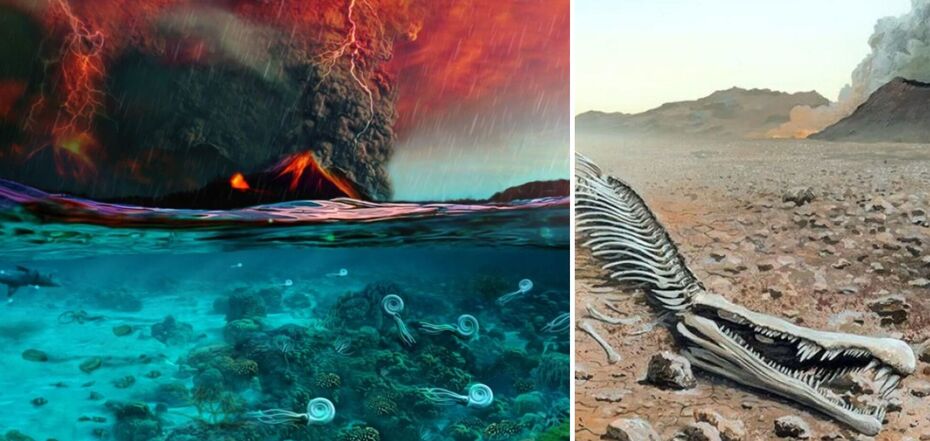Life
Scientists discover 'killer' that caused two mass extinctions on Earth: it still threatens humans
Two mass extinctions millions of years apart that occurred during the Middle Permian period were caused by powerful volcanic eruptions and the global warming that followed. Although such eruptions are unlikely to occur today, humanity itself is causing climate change that could lead to similar results.
The data on ancient volcanic eruptions were discovered during the study of uranium isotope profiles in marine samples. The scientists reported the results of their work in an article in the journal Earth and Planetary Science Letters.
The mass extinction of animals occurred about 260 million years ago. Previously, it was believed that this was a single event that led to the death of a significant part of living organisms on Earth. Now scientists believe that not one, but two extinctions occurred three million years apart. Both were caused by volcanic eruptions, which led to the oceans losing oxygen.
By studying the uranium isotope profiles of marine samples collected in the South China Sea, scientists have discovered two "pulses" that prove that oceans deprived of life-giving oxygen accelerated two mass extinctions around 259 million and 262 million years ago.
Scientists explain that studying ancient mass extinctions will help researchers better predict how modern global warming may affect the ocean food chain.
"Similar warming is happening today due to human activity. Humans are mimicking the effects of volcanic eruptions by emitting carbon into the atmosphere," explained Thomas Algeo, co-author of the study and professor of geosciences at the University of Cincinnati (USA).
Another study participant, Huiyue Song from the China University of Geosciences, also noted the similarities between what is happening now and ancient extinctions.
"Today, we are facing several global change issues, including global warming, ocean hypoxia (oxygen deprivation - Ed.), seawater acidification, and biodiversity decline, similar to the environmental changes during the Middle Permian biological crisis," Song said.
He also noted that all of these events are now happening much faster than in the distant past.
How volcanic eruptions lead to extinction
During massive volcanic eruptions, ash is ejected into the upper atmosphere, reflecting sunlight. This leads to a short cooling period followed by much longer periods of global warming.
The emission of huge volumes of greenhouse gases warms the oceans, which causes warm surface water to prevent dissolved oxygen from sinking to shallower depths. This leads to the destruction of the food chain.
Scientists warn humanity that since global warming has such devastating consequences for life on Earth, it is necessary to seriously address this problem.
"We need to pay attention to these environmental issues and prevent the sixth mass extinction," Song said.
Scientists had previously suspected that volcanic eruptions were one of the main causes of mass extinction, but there was no evidence for this theory.
Scientists also do not yet understand why the Earth had to experience three such devastating eruptions in 10 million years.
How many mass extinctions have there been on Earth?
The Earth has experienced five officially recognised mass extinctions, during which a significant proportion of life on the planet disappeared. The most powerful extinction occurred at the end of the Permian period, approximately 252 million years ago.
Scientists also do not rule out the possibility that the Earth is experiencing an early stage of the sixth extinction caused by human activity. However, there is controversy over whether the sixth extinction has already begun. In particular, because we are witnessing the disappearance of certain types of animals, not entire species.
In the absence of agreement on what it takes to qualify as a mass extinction event, scientists look at historical definitions and why some events have been classified as mass extinctions and others have not. And then they try to project these conditions onto the current state of affairs.
Part of the disagreement stems from the fact that biologists and palaeontologists look at extinctions differently. Biologists and ecologists count the loss of each individual species, because if it has disappeared, we will never see another like it again.
Ancient extinctions, on the other hand, take the loss of an entire genus as a unit of measurement. Since humans are the only surviving members of the genus Homo, it is very easy to identify a mass extinction of humanity. However, there is a species called Panthera, which includes lions, tigers, jaguars and two species of leopards. For palaeontologists to declare a mass extinction of this species, all five of its representatives would have to become extinct.
There have been many other moments in the history of the Earth when species disappeared much faster than new ones replaced them, and paleontologists have long debated whether they deserve to be considered mass extinctions as well.
Earlier, OBOZREVATEL also reported that global warming and melting glaciers could release chemicals into the atmosphere that have been emitted by humans for decades. This will put humanity on the brink of not only a climate but also an environmental disaster.
Subscribe to OBOZREVATEL's Telegram and Viber channels to keep up with the latest news.



























